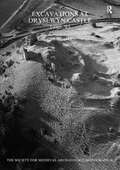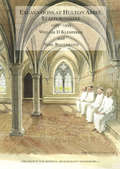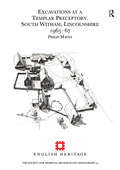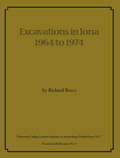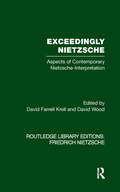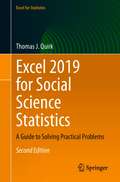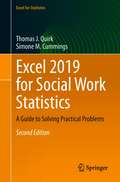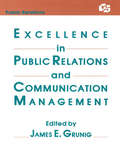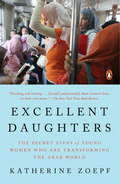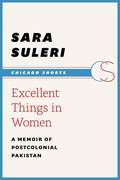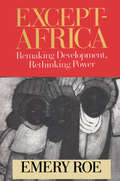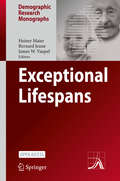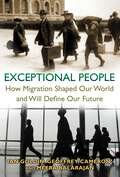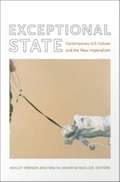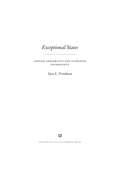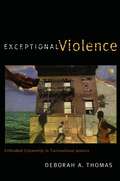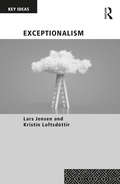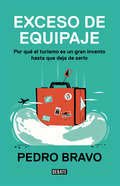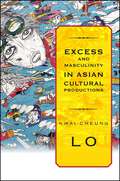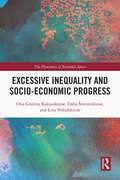- Table View
- List View
Excavations at Dryslwyn Castle 1980-1995 (The Society for Medieval Archaeology Monographs)
by Chris Caple"Excavations at Dryslwyn between 1980 and 1995 uncovered a masonry castle, founded in the late 1220s by Rhys Gryg for his son Maredudd ap Rhys, the first Lord of Dryslwyn. The first castle was a simple round tower and polygonal walled enclosure, within which were constructed a kitchen, prison and wood-framed, clay-floored great chamber beside a great hall. In the mid 13th century a second ward was added and the great chamber rebuilt in stone. This castle was greatly expanded in the period 1283-87 by Rhys ap Maredudd, the second and final Lord of Dryslwyn, who built an Outer Ward and gatehouse. He also rebuilt much of the Inner Ward, adding an extra storey to the great hall and great chamber, apartments and a chapel. At the end of the 13th century a large three-ward castle stretched along the eastern and southern edge of the hill while the rest of the hilltop was occupied by a settlement defended by a wall and substantial ditch with access through a gatehouse. This castle and its associated settlement were besieged and captured in 1287 by an English royal army of over 11,000 men following damage inflicted by a trebuchet and mining of the walls. Throughout the 14th century the English Crown garrisoned and repaired the castle, supervised by an appointed constable, before it was surrendered to Owain Glyn Dwr in 1403. During the early to mid 15th century the castle was deliberately walled up to deny its use to a potential enemy and it was subsequently looted and demolished. By the late 13th century, the castle had a white rendered and lime-washed appearance, creating a very dramatic and highly visible symbol of lordship. Internally, the lord's and guest apartments had decorative wall paintings and glazed windows. Evidence from charred beams still in situ, the sizes, shapes and distribution of nails, sheet lead, slates and postholes recovered during excavation has enabled some of the wooden as well as masonry buildings to be reconstructed. Waterlogged deposits had preserved a rich assemblage of seeds, birds, fish and animal bone which reveal evidence of the dining habits of Welsh lords, their guests and household. Of particular interest are the finds associated with the siege of 1287 which include a knop-headed mace, spearheads and armour-piercing arrowheads which indicates that the longbow was the weapon of choice. Damage and repairs to the castle walls correlate with historic accounts while three stone balls recovered by the excavation were undoubtedly thrown by the trebuchet recorded in contemporary accounts."
Excavations at Glasgow Cathedral 1988-1997 (The Society for Medieval Archaeology Monographs)
by Stephen T. DriscollIn 1988 extensive archaeological investigations began at Glasgow Cathedral revealing evidence for the first cathedral built in 1136 and subsequent 12th century phases.
Excavations at Hulton Abbey, Staffordshire 1987-1994 (The Society for Medieval Archaeology Monographs)
by William D. Klemperer"Hulton Abbey was a minor Cistercian monastery in north Staffordshire (England), founded in 1219 and finally dissolved in 1538. This is the final report on the archaeological excavations undertaken there between 1987 and 1994. In particular, the chapter house was uncovered and re-assessed and the eastern part of the church and north aisle were completely excavated, together with the eastern half of the nave. The excavations are described by area and chronological phase with detailed specialist reports including architectural stonework and decorated floor tiles. An extensive programme of sampling and analysis of pollen remains from burials was also completed. The remains of 91 individuals, mainly men but also women and children, are reported on in detail, with sections on abnormalities and pathology as well as medieval burial goods such as a wax chalice and wooden wands. Comparisons with other published monastic sites in the region help to place Hulton into a wider context. An important element of the project was education and community involvement and today the site lies in a small urban park in Stoke-on-Trent."
Excavations at a Templar Preceptory, South Witham, Lincolnshire 1965-67 (The Society for Medieval Archaeology Monographs)
by Philip Mayes"The excavations at South Witham in Lincolnshire produced the most complete archaeological plan of the preceptory of the Military Orders so far seen in Britain. Before 1965 there had been only limited investigation of Knights Templar houses and evidence for day-to-day activities was almost non-existent. Never before had the different components of a preceptory been examined in detail using modern archaeological techniques. This monograph presents the final publication of results, beginning with separate chapters dedicated to the three main phases of occupation.Land in South Witham was first acquired by the Templars between 1137 and 1185 and thereafter a series of buildings was constructed throughout the late 12th and 13th centuries. The preceptory may already have been in decline before the final arrest and dissolution of the Order in the early 14th century. All the well-preserved buildings are described in detail by the excavation director, including the barns, blacksmith's forge, brewhouse, chapel, gateshouse, granaries, Great Hall, kitchen ranges, watermill and workshops.The text is enriched by many photomosaics and aerial photographs. This archaeological evidence then provides the basis for a well-illustrated discussion of architectural reconstructions by John Smith while the documentary background is summarised by Eileen Gooder. Among the finds discussed by a range of specialists are coins (Rigold), metalwork (Goodall), a prehistoric flat axe (Davey), objects of bone and antler (MacGregor), pottery (Johnson), architectural fragments (Gee) and painted wall plaster (Rouse). Environmental and industrial evidence are also considered, including animal bone (Harcourt), metal-working residues (Morgan) and human skeletal remains (Manchester)."
Excavations in Iona 1964 to 1974 (UCL Institute of Archaeology Publications)
by Richard ReeceThis volume contains numerous studies of a medieval religious compound from rescue excavations conducted on the island of Iona, off the coast of Scotland.
Excavations in Residential Areas of Tikal--Group 7F-1: Tikal Report 22
by William A. HavilandTikal Report 22 presents the results of excavations carried out in residential group 7F-1 at Tikal in Guatemala during the 1957, 1963, and 1965 seasons. As with similar Tikal Reports (TR 19, TR 20A/20B, and TR 21), TR 22 is devoted to the presentation of detailed excavation data and analysis. In this case, the residential group presented may have been home to descendants of a ruler who died in the sixth century C.E.
Exceedingly Nietzsche: Aspects of Contemporary Nietzsche Interpretation
by David Farrell KrellOriginally published in 1988, this collection brings together a wide range of original readings on Friedrich Nietzsche, reflecting many aspects of Neitzsche in contemporary philosophy, literature and the social sciences. The Nietzsche these contributors discuss is the Nietzsche who exceeds any attempt at determinate interpretation, the Nietzsche whose capacity for renewing thought seems limitless. This is a powerful collection of essays and a major contribution to modern Nietzsche interpretation.
Excel 2019 for Social Science Statistics: A Guide to Solving Practical Problems (Excel for Statistics)
by Thomas J. QuirkThis book shows the capabilities of Microsoft Excel in teaching social science statistics effectively. Similar to the previously published Excel 2016 for Social Sciences Statistics, this book is a step-by-step, exercise-driven guide for students and practitioners who need to master Excel to solve practical social science problems. If understanding statistics isn’t your strongest suit, you are not especially mathematically inclined, or you are wary of computers, this is the right book for you.Excel, a widely available computer program for students and managers, is also an effective teaching and learning tool for quantitative analyses in social science courses. Its powerful computational ability and graphical functions make learning statistics much easier than in years past. Excel 2019 for Social Science Statistics: A Guide to Solving Practical Problems capitalizes on these improvements by teaching students and managers how to apply Excel to statistical techniques necessary in their courses and work.In this new edition, each chapter explains statistical formulas and directs the reader to use Excel commands to solve specific, easy-to-understand social science problems. Practice problems are provided at the end of each chapter with their solutions in an appendix. Separately, there is a full practice test (with answers in an appendix) that allows readers to test what they have learned.
Excel 2019 for Social Work Statistics: A Guide to Solving Practical Problems (Excel for Statistics)
by Thomas J. Quirk Simone M. CummingsThis text is a step-by-step, exercise-driven guide for students and practitioners who need to master Excel to solve practical social work problems. If understanding statistics isn’t your strongest suit, you are not especially mathematically inclined, or if you are wary of computers, this is the right book for you. Excel, a widely available computer program for students and managers, is also an effective teaching and learning tool for quantitative analyses in social work courses. Its powerful computational ability and graphical functions make learning statistics much easier than in years past. Excel 2019 for Social Work Statistics: A Guide to Solving Practical Problems capitalizes on these improvements by teaching students and managers how to apply Excel to statistical techniques necessary in their courses and work. In this new edition, each chapter explains statistical formulas and directs the reader to use Excel commands to solve specific, easy-to-understand social work problems. Practice problems are provided at the end of each chapter with their solutions in an Appendix. Separately, there is a full Practice Test (with answers in an Appendix) that allows readers to test what they have learned.
Excellence in Public Relations and Communication Management (Routledge Communication Series)
by James E. Grunig Larissa A. Grunig Jon White David M. Dozier William P. Ehling Fred C. RepperThis book is the initial volume coming out of the "excellence project"--a comprehensive research effort commissioned by the IABC (International Association of Business Communicators) Research Foundation. The purpose of this project was to answer two fundamental questions about public relations: What are the characteristics of an excellent communication department? How does excellent public relations make an organization more effective, and how much is that contribution worth economically? The research team began its work with a thorough review of the literature in public relations and related disciplines relevant to these questions. What started as a literature review, however, has ended in a general theory of public relations, one that integrates most of the wide range of ideas about, and practices of, communication management in organizations.
Excellent Daughters
by Katherine ZoepfFor more than a decade, Katherine Zoepf has lived in or traveled throughout the Arab world, reporting on the lives of women, whose role in the region has never been more in flux. Only a generation ago, female adolescence as we know it in the West did not exist in the Middle East. There were only children and married women. Today, young Arab women outnumber men in universities, and a few are beginning to face down religious and social tradition in order to live independently, to delay marriage, and to pursue professional goals. Hundreds of thousands of devout girls and women are attending Qur'anic schools--and using the training to argue for greater rights and freedoms from an Islamic perspective. And, in 2011, young women helped to lead antigovernment protests in the Arab Spring. But their voices have not been heard. Their stories have not been told.In Syria before its civil warshe documents a complex society in the midst of soul searching about its place in the world and about the role of women. In Lebanon, she documents a country that on the surface is freer than other Arab nations but whose women must balance extreme standards of self-presentation with Islamic codes of virtue. In Abu Dhabi, Zoepf reports on a generation of Arab women who've found freedom in work outside the home. In Saudi Arabia she chronicles driving protests and women entering the retail industry for the first time. In the aftermath of Tahrir Square, she examines the crucial role of women in Egypt's popular uprising. Deeply informed, heartfelt, and urgent, Good Daughters brings us a new understanding of the changing Arab societies--from 9/11 to Tahrir Square to the rise of ISIS--and gives voice to the remarkable women at the forefront of this change.
Excellent Daughters: The Secret Lives of Young Women Who Are Transforming the Arab World
by Katherine ZoepfFor more than a decade, Katherine Zoepf has lived in or traveled throughout the Arab world, reporting on the lives of women, whose role in the region has never been more in flux. Only a generation ago, female adolescence as we know it in the West did not exist in the Middle East. There were only children and married women. Today, young Arab women outnumber men in universities, and a few are beginning to face down religious and social tradition in order to live independently, to delay marriage, and to pursue professional goals. Hundreds of thousands of devout girls and women are attending Qur’anic schools—and using the training to argue for greater rights and freedoms from an Islamic perspective. And, in 2011, young women helped to lead antigovernment protests in the Arab Spring. But their voices have not been heard. Their stories have not been told.In Syria, before its civil war, she documents a complex society in the midst of soul searching about its place in the world and about the role of women. In Lebanon, she documents a country that on the surface is freer than other Arab nations but whose women must balance extreme standards of self-presentation with Islamic codes of virtue. In Abu Dhabi, Zoepf reports on a generation of Arab women who’ve found freedom in work outside the home. In Saudi Arabia she chronicles driving protests and women entering the retail industry for the first time. In the aftermath of Tahrir Square, she examines the crucial role of women in Egypt's popular uprising. Deeply informed, heartfelt, and urgent, Excellent Daughters brings us a new understanding of the changing Arab societies—from 9/11 to Tahrir Square to the rise of ISIS—and gives voice to the remarkable women at the forefront of this change.From the Hardcover edition.
Excellent Things in Women: A Memoir of Postcolonial Pakistan (Chicago Shorts)
by Sara SuleriSometimes, only the most heartbreaking memories possess the capacity--in their elegiac immediacy--to take our breath away. With Excellent Things in Women, Sara Suleri offers the reader a delicately wrought memoir of life in postcolonial Pakistan. Suleri intertwines the violent history of Pakistan's independence with her own intimate experiences--relating the tumult of growing up female during a time of fierce change in the Middle East in the 1960s and '70s. In the two selections presented here, "Excellent Things in Women" and "Meatless Days," we watch as Suleri re-encounters the relationships that inform her voyage from adolescence to womanhood--with her Welsh mother; her Pakistani father, prominent political journalist Z. A. Suleri; and her tenacious grandmother, Dadi, along with her five siblings--as she comes to terms with the difficulties of growing up and her own complicated passage to the West.
Except-Africa: Remaking Development, Rethinking Power
by Emery RoeFirst Published in 2018. Routledge is an imprint of Taylor & Francis, an Informa company.
Exceptional Experiences: Engaging with Jolting Events in Art and Fieldwork
by Helena Wulff Petra RethmannLooking at encounters that can puncture or jolt us, this volume uses art as a lens through which to register and understand exceptional experiences. The volume also includes the fieldworker’s experience of unexpected events that can lead to key understandings, as well as revelatory moments that happen during artistic creation and while looking at art. By exploring exceptional experiences through art, the volume asks probing questions for anthropology. In recognizing that art is all-encompassing – including, as it does, narrative, performance, dance and images – Exceptional Experiences situates itself within a number of conversations on methodological and conceptual issues in anthropology and beyond.
Exceptional Experiences: Engaging with Jolting Events in Art and Fieldwork
by Helena Wulff Petra RethmannLooking at encounters that can puncture or jolt us, this volume uses art as a lens through which to register and understand exceptional experiences. The volume also includes the fieldworker’s experience of unexpected events that can lead to key understandings, as well as revelatory moments that happen during artistic creation and while looking at art. By exploring exceptional experiences through art, the volume asks probing questions for anthropology. In recognizing that art is all-encompassing – including, as it does, narrative, performance, dance and images – Exceptional Experiences situates itself within a number of conversations on methodological and conceptual issues in anthropology and beyond.
Exceptional Lifespans (Demographic Research Monographs)
by James W. Vaupel Heiner Maier Bernard JeuneHow long can humans live? This open access book documents, verifies and brings to life the advance of the frontier of human survival. It carefully validates data on supercentenarians, aged 110+, and semi-supercentenarians, aged 105-109, stored in the International Database on Longevity (IDL). The chapters in this book contribute substantial advances in rigorously checked facts about exceptional lifespans and in the application of state-of-the-art analytical strategies to understand trends and patterns in these rare lifespans. The book includes detailed accounts of extreme long-livers and how their long lifespans were documented, as well as reports on the causes of death at the oldest ages. Its key finding, based on the analysis of 1,219 validated supercentenarians, is that the annual probability of death is constant at 50% after age 110. In contrast to previous assertions about a ceiling on the human lifespan, evidence presented in this book suggests that lifespan records in specific countries and globally will be broken again and again as more people survive to become supercentenarians.
Exceptional People: How Migration Shaped Our World and Will Define Our Future
by Ian Goldin Geoffrey Cameron Meera BalarajanThe past, present, and future role of global migrationThroughout history, migrants have fueled the engine of human progress. Their movement has sparked innovation, spread ideas, relieved poverty, and laid the foundations for a global economy. In a world more interconnected than ever before, the number of people with the means and motivation to migrate will only increase. Exceptional People provides a long-term and global perspective on the implications and policy options for societies the world over. Challenging the received wisdom that a dramatic growth in migration is undesirable, the book proposes new approaches for governance that will embrace this international mobility.The authors explore the critical role of human migration since humans first departed Africa some fifty thousand years ago—how the circulation of ideas and technologies has benefited communities and how the movement of people across oceans and continents has fueled economies. They show that migrants in today's world connect markets, fill labor gaps, and enrich social diversity. Migration also allows individuals to escape destitution, human rights abuses, and repressive regimes. However, the authors indicate that most current migration policies are based on misconceptions and fears about migration's long-term contributions and social dynamics. Future policies, for good or ill, will dramatically determine whether societies can effectively reap migration's opportunities while managing the risks of the twenty-first century.A guide to vigorous debate and action, Exceptional People charts the past and present of international migration and makes practical recommendations that will allow everyone to benefit from its unstoppable future growth.
Exceptional State: Contemporary U.S. Culture and the New Imperialism
by Ashley Dawson Malini Johar SchuellerExceptional State analyzes the nexus of culture and contemporary manifestations of U. S. imperialism. The contributors, established and emerging cultural studies scholars, define culture broadly to include a range of media, literature, and political discourse. They do not posit September 11, 2001 as the beginning of U. S. belligerence and authoritarianism at home and abroad, but they do provide context for understanding U. S. responses to and uses of that event. Taken together, the essays stress both the continuities and discontinuities embodied in a present-day U. S. imperialism constituted through expressions of millennialism, exceptionalism, technological might, and visions of world dominance. The contributors address a range of topics, paying particular attention to the dynamics of gender and race. Their essays include a surprising reading of the ostensibly liberal movies Wag the Dog and Three Kings, an exploration of the rhetoric surrounding the plan to remake the military into a high-tech force less dependent on human bodies, a look at the significance of the popular Left Behind series of novels, and an interpretation of the Abu Ghraib prison photos. They scrutinize the national narrative created to justify the U. S. invasions of Afghanistan and Iraq, the ways that women in those countries have responded to the invasions, the contradictions underlying calls for U. S. humanitarian interventions, and the role of Africa in the U. S. imperial imagination. The volume concludes on a hopeful note, with a look at an emerging anti-imperialist public sphere. Contributors. Omar Dahbour, Ashley Dawson, Cynthia Enloe, Melani McAlister, Christian Parenti, Donald E. Pease, John Carlos Rowe, Malini Johar Schueller, Harilaos Stecopoulos
Exceptional States
by Sara L. FriedmanExceptional States examines new configurations of marriage, immigration, and sovereignty emerging in an increasingly mobile Asia where Cold War legacies continue to shape contemporary political struggles over sovereignty and citizenship. Focused on marital immigration from China to Taiwan, the book documents the struggles of these women and men as they seek acceptance and recognition in their new home. Through tracing parallels between the predicaments of Chinese marital immigrants and the uncertain future of the Taiwan nation-state, the book shows how intimate attachments and emotional investments infuse the governmental practices of Taiwanese bureaucrats charged with regulating immigration and producing citizenship and sovereignty. Its attention to a group of immigrants whose exceptional status has become necessary to Taiwan's national integrity exposes the social, political, and subjective consequences of life on the margins of citizenship and sovereignty.
Exceptional Violence: Embodied Citizenship in Transnational Jamaica
by Deborah A. ThomasExceptional Violence is a sophisticated examination of postcolonial state formation in the Caribbean, considered across time and space, from the period of imperial New World expansion to the contemporary neoliberal era, and from neighborhood dynamics in Kingston to transnational socioeconomic and political fields. Deborah A. Thomas takes as her immediate focus violence in Jamaica and representations of that violence as they circulate within the country and abroad. Through an analysis encompassing Kingston communities, Jamaica's national media, works of popular culture, notions of respectability, practices of punishment and discipline during slavery, the effects of intensified migration, and Jamaica's national cultural policy, Thomas develops several arguments. Violence in Jamaica is the complicated result of a structural history of colonialism and underdevelopment, not a cultural characteristic passed from one generation to the next. Citizenship is embodied; scholars must be attentive to how race, gender, and sexuality have been made to matter over time. Suggesting that anthropologists in the United States should engage more deeply with history and political economy, Thomas mobilizes a concept of reparations as a framework for thinking, a rubric useful in its emphasis on structural and historical lineages.
Exceptionalism: Exceptionalism, Migrant Others And National Identities (Key Ideas)
by Lars Jensen Kristín LoftsdóttirThis volume crucially provides an analytical and comparative approach, investigating the meaning and uses of the concept of exceptionalism, while demonstrating the ways in which it manifests itself in different historical and geographical settings. Exceptionalism offers comparative case studies from different parts of the world, showcasing the way in which exceptionalism has come to occupy an important narrative position in relation to different nation-states, including the United States, the United Kingdom, the Nordic countries, various European nations and countries in Latin America, Africa and Asia. An introduction to and overview of a term that has come to define the past and present identity of many nations, this book will appeal to scholars of sociology, anthropology, geography, cultural studies and politics.
Exceso de equipaje: Por qué el turismo es un gran invento hasta que deja de serlo
by Pedro BravoUna serie de historias cruzadas sobre el turismo y su evolución en los últimos tiempos. De repente, en el país que presume de ser el mejor destino turístico del mundo ha surgido un movimiento de rechazo a su industria más próspera. Los españoles viajamos cada vez más pero también empezamos a darnos cuenta de los defectos que se ocultan al otro lado de la postal. ¿Qué ha pasado? ¿De dónde sale la turismofobia? ¿No estábamos todos de acuerdo en que el turismo era una actividad rentable, simpática y limpia? En todo el mundo, no solo en España, han surgido voces críticas y se han organizado protestas; la gente rechaza ver cómo su vida recibe el impacto de un negocio al que parece que se le permite todo. Un negocio que cambia, crece y se extiende a toda velocidad gracias a la tecnología y a las contradicciones de los territorios que lo sufren sin dejar de potenciarlo. El turismo genera empleo pero este es precario y estacional.El turismo aporta músculo a la macroeconomía pero afecta cada vez más el mercado de la vivienda. El turismo es una oportunidad para el encuentro pero puede devenir en invasión. Y, sí, es muy contaminante. ¿Cómo hemos llegado hasta aquí? ¿Cuáles son las claves del sector? ¿Cuáles son sus beneficios? ¿Cuánto turismo es suficiente y cuánto es demasiado? ¿Cómo nos afecta? ¿Se puede hacer de otra manera? ¿Se puede viajar de otro modo? De todo esto trata Exceso de equipaje, algo así como una guía turística por el negocio turístico.
Excess and Masculinity in Asian Cultural Productions (SUNY series in Global Modernity)
by Kwai-Cheung LoIn Excess and Masculinity in Asian Cultural Productions, Kwai-Cheung Lo explores the excesses associated with the phenomenal economic growth in East Asia, including surplus capital, environmental waste, and the unbalanced ratio of men to women in the region, connecting the production of capitalist "excess" to the production of new forms of transnational Asian masculinity. Lo draws on Lacanian psychoanalysis and Marxist ideas as well as gender theory in his examination of East Asian cultural products such as religious and parenting books, transgender literary fantasies, travel writing, gangster movies, female action heroes, and online games. Through this analysis, Lo argues that the excess of Asia's "masculine" modernization throws into relief the internal inconsistencies of capitalism itself, posing new challenges to the order of global capitalism and suggesting new possible configurations of global modernity.
Excessive Inequality and Socio-Economic Progress (The Dynamics of Economic Space)
by Dalia Štreimikienė Ona Gražina Rakauskienė Lina VolodzkienėThe growing inequality in the global economy across the planet is reaching unprecedented levels. This book seeks to develop frameworks for the assessment of excessive inequality and its impact on social-economic progress and sustainable development. It begins by summarizing the theoretical approaches of economic inequality, its specificity, and questioning what economic inequality really is and how it progresses. Next, the book explores issues of methodology for addressing the growing excessive economic inequality. It then applies these concepts to examine inequality across a range of the European Union (EU) countries. A variety of factors are considered, such as the impact of economic inequality on socio-economic progress, when normal inequality turns into excessive inequality, and its impact on economic growth, quality of life, and the environmental sustainability across different groups.
